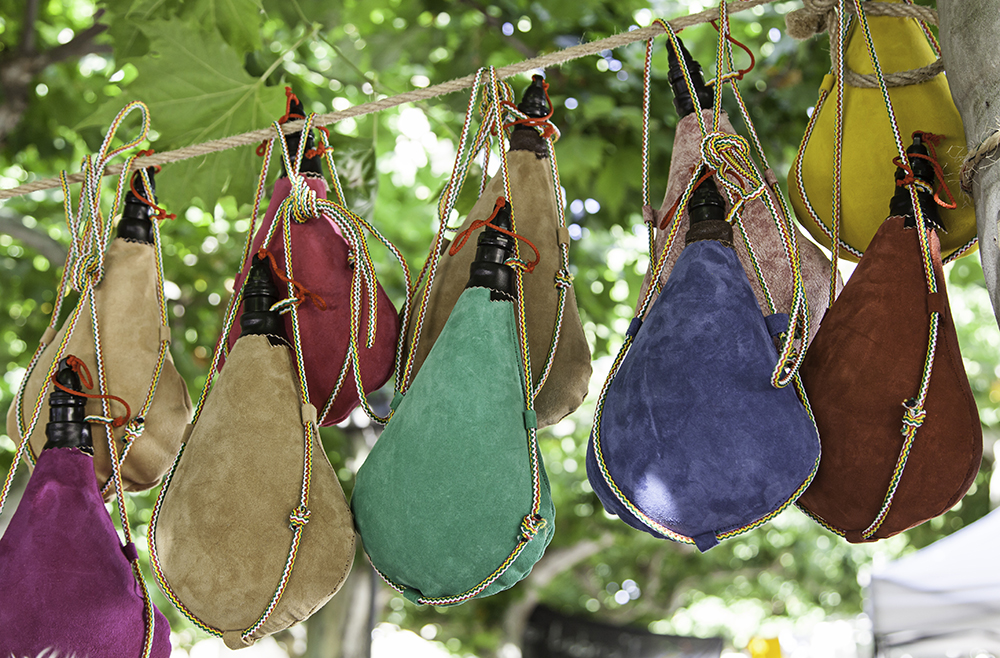
Storing swill goes back thousands of years.
The oldest known winery opened its doors in 4100 BC. Archeologists discovered it inside an Armenian cave. Perhaps it was the first speakeasy.
Way back in the day, fermented drink wasn’t stored in a sleek glass bottle branded with an ironic name or conveniently bagged inside a cardboard box with a handy spout. And it didn’t come in a can. Wine packaging has come quite a long way through the millennia.
First Wine Goes to Pot
Around 6000 BC, large earthenware vessels were crafted to store alcohol. Of Georgian origin, the jugs usually held about 800 litres or enough for a good block party.
The containers are called kvevri, sometimes spelled qvevri – but always pronounced: kway-vree.
The earliest winemakers infused their own terroir into their bevies through the clay chosen to make the pots used to age and store the drink. Jars were coated with beeswax and sealed with resin to keep air from reaching the liquid inside.
Wineskin in the Game
Large, buried earthenware pots left a lot to be desired when it came to portability for weekend getaways. That led to one of the first variations of a hip flask: wineskins. They were usually made from sheep or goat skins (hence the name).
Similar to the fanny pack, they were a fad that took off from ancient Greece to the Middle East. They became so prevalent in pop culture that Jesus even referenced them to connect with his target audience (Matthew 9:17).
It Takes Some Gaul
Clay pots were eventually replaced by barrels in large-scale storage and winemaking.
The Gauls, a group of Celtic peoples, were credited with first using barrels for alcohol and transporting beer in wood containers bound with metal hoops. The Gaul practice went mainstream after being discovered by the Romans. Winemakers in France later adopted the use of oak barrels in their techniques, with much success as it’s a longstanding practice.
Not only was the ancient Romans’ success in conquering others pivotal in the use of barrels but they were also noted as early adopters of wine bottles. The oldest unopened wine bottle is about 1,700 years old. It was discovered in Speyer, Germany, and was still filled with a Roman vintage.
Glass from the Past
Secrets to Roman glass blowing were lost, but the Dark Ages did bring forth green-coloured bottles that people living in the forest made using wood ash and sand.
Glass-making techniques evolved over the following centuries into fine art, with master glassmakers in Italy during The Renaissance creating the most sought-after glass in Europe.
Branded wine bottles were discovered in England dating back to the mid-to late-17th century, with seals signifying the tavern they came from. Symbols include a crown, mermaid, and king’s head, early examples of social media marketing with a bottle-delivery service as a side hustle.
Vive la Révolution
Large-scale glass-making emerged in the 17th century along with the Industrial Revolution.
The creation of tinted glass and the coinciding invention of corks, along with increasingly large-scale manufacturing plants, brought forth the ubiquitous wine bottle. They were all made in a similar shape, so the unwashed masses could ship them efficiently and store them.
Thanks to an insatiable need to increase corporate profits and executive bonuses, wine had officially gone commercial.
Bag in a Box
Packaging became even more varied over the years with industrial progress.
The countercultural revolution of the 1960s brought both bra-burning and boxed wine. ‘Bag-in-box’ technology put a strong plastic ‘bladder’ inside a rectangular box. It was first invented to hold battery acid but seemed to perform just as well with wine.
The method proved convenient and cost-effective, if not controversial at the time.
What Next?
Wine packaging continues to evolve, from cans to Tetra Paks, to bottles of all shapes and sizes.
For those who want a little sci-fi with their wine, innovative marketers are using augmented reality that makes labels come alive under the scrutiny of a cellphone camera.
Bottles are getting lighter to reduce their carbon footprint.
High-end packaging uses insulated materials to keep the temperature of wine stable at all times.
Bottles are even being treated with UV-protective coatings to keep out the sun’s rays. It’s a good reminder that everybody needs to use protection.
So there you have it. Even in the face of unstoppable modern advancement, no other packaging comes close to usurping the wine bottle. Though they may get a little dicey floating around in space when future Astro-tourists want to pop a bottle of bubbly in zero-G.